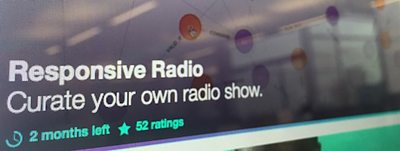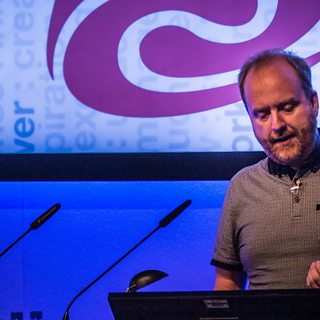
What if your favourite programme knew more about you? This post discusses how a new approach to broadcasting could enable more personalised, accessible programmes and services.
In this post I’m going to discuss why we might want to use object-based broadcasting to personalise and create programmes for individual audience members, and how we’d go about doing it. We’ll start off with Personalised Audio, and build up to more complex examples like Responsive Radio.
Personalised Audio
At the simpler end of the spectrum, OBB enables personalised audio mixes. An broadcast a football match as three audio objects - one for commentary, and one for the crowd noise at each end of the stadium. This OBB approach enabled listeners to ‘sit' anywhere in the stadium, as well as alter the volume of the commentary.
I expect personalised audio to be a common feature of object-based broadcasts. To enable this degree of audio personalisation, programme makers need to create two separate objects - the video with presenter dialog, and the music. Your device will pick up on this, and present a user interface with independent volume controls.
Independent volume controls in Responsive Radio
Allowing people to adjust audio balance addresses personal preferences, noisy listening environments, and accessibility factors such as hearing loss - without having any impact on the programme content itself. So, what about programmes that can vary their content for different viewers?
Tailored Programmes
I like the news, but I don’t like sport. I’ll eat pretty much anything apart from celery. I’d be happy to opt out of any sports stories, and have them replaced with other stories that I might be interested in. I’d also be happy to never see a celery recipe - could I have that ingredient replaced, or maybe have a different recipe instead? This presents an interesting challenge for OBB: dynamic, seamless replacement of parts of both live and on-demand broadcasts with alternative content. To make this idea work, the alternative content objects may have to be altered to fit exactly into the duration of the slot they are replacing. Certainly a challenge, but one that we’re already starting to tackle with projects like Responsive Radio.
Being able to tailor programmes in this way also brings non-technical challenges. Avoiding celery seems like a fairly safe thing to do - but when it comes to journalism, do we need to limit audience curation of content in order to retain editorial intent and unbiased coverage of stories? How do we avoid ?
Binge Watching
Now that iPlayer has , you might find yourself watching two episodes of your favourite drama or competition show back to back. How do you feel about the plot being recapped at the start of the second episode? Has it become unnecessary? A quick and simple user interaction during the first episode could indicate that you want the first episode to run seamlessly into the second. To achieve this with OBB would require each episode to be split into four separate objects: titles, recap, episode and credits. Your device could skip the first episode’s credits, the second episode’s title sequence and plot recap, and create a seamless double-length episode for you.
Responsive Captioning

Responsive �鶹Լ�� News Ticker
Object-based broadcasting can be used to improve the viewing experience for on-screen captions such as news tickers or sports results. For some viewers watching on smaller mobile devices, these graphical layers of information can be quite hard to read. By transmitting them as objects, rather than burning them in to the video, we will be able to use responsive design principles to ensure that they are legible, and positioned sensibly, no matter what device you’re watching on.
Multi-Device
Going a little further than this, individual objects could be sent to different devices around your home. This opens up some really interesting opportunities. As well as personalising graphical layers, they could be moved from the main screen to your phone, tablet or smart watch. Let’s think bigger than this, though - if we can send any object from a broadcast to any device, we could use every connected device in your home as a screen or a speaker. I don’t know about you, but I’m imagining the scariest episode of Doctor Who there’s ever been.
Catching Up
I’m very keen on applying OBB to create personalised catch-up programmes for situations where you’ve missed several episodes of a scheduled show and want to get back in sync with it as quickly as possible. With OBB, it’s possible that we could construct a programme that brings you up to date with the previous episodes before the next one starts.

Many, many MasterChefs
Let’s imagine you’ve missed several episodes of Master chef while you were on holiday. MasterChef has a readily understood format which breaks down neatly into objects. For each contestant in each round, the production team film what they cooked, how they cooked it, what the judges thought of it, and what the contestant thought of their performance. The judges make their judgements, and a contestant leaves the show. If each of these sequences was an object, and you’d chosen to share your viewing habits with the �鶹Լ��, OBB could instantly create a unique catchup programme tailored exactly to your requirements.
It’s easy to see catchup for tightly formatted shows like MasterChef working. But maybe you also missed EastEnders whilst topping up your tan. Creating a catchup programme for a continuing drama like EastEnders will be a lot trickier than for more consistent formats like MasterChef. Multiple storylines, many characters, story arcs taking place across episodes, weeks or even months will need to be considered, and the production data required to drive the generation of catchup programmes will be more complicated.
We’re at the complex end of the object-based experience here: an EastEnders catchup service would require a deep digital understanding of narrative, rather than an understanding of a programme format. This area is precisely what we’ve started to tackle with the Responsive Radio project.
Satnav For Stories
As I explained at the top of the post, Responsive Radio is a radio documentary that can adjust itself to fit the time you have available to listen. As a member of the audience, your interaction with this experience couldn’t be simpler - set a slider to how long you want the programme to be, sit back and enjoy your programme. However, behind that simple interaction is the most complex example of OBB that we’re currently aware of.
Compared to dropping a replacement recipe into a tailored cooking programme, Responsive Radio is much higher in complexity, using 111 objects - 99 pieces of dialog, 11 pieces of music, and one recording of a seagull. They’re also connected in a rather more intricate fashion, as you can see below.

A section of Responsive Radio's Narrative Map
What you’re looking at here is a section of a map. The moment you decide how long you want our Responsive Radio programme to be, we consult the map. Instead of featuring place names connected by roads, our map comprises story elements connected by narrative pathways. It’s a digital representation of the documentary’s story and themes.
To help us chart a route through our map, we also created a satnav. The satnav understands our map, and can answer questions like "How do we get from the beginning of the story to the end, passing through all the crucial moments, in 17 minutes?”. The satnav’s response to this question is to generate a radio programme that tells its story in at the length specified, and hopefully sounds just as polished as the original.
Our story satnav can only ever be as good as the map it’s working with. I’ll cover the process of creating the map for Responsive Radio in another post, but if you’re really keen, this discusses it in some detail.
Bring on the programme makers
From personalised audio to programmes created on demand just for you, I hope this post has given you some insight into the different kinds of experiences that object-based broadcasting can deliver. A new approach like this, combining the best of today’s technologies with the craft of storytelling, will enable programme makers to inform, educate and entertain in ways we can’t yet imagine.
Of course, there are many challenges ahead - the storage and broadcasting of individual objects, and the real-time compositing of objects back into a programme on a variety of devices, for example.
However, for me, the most interesting challenges aren’t technical. Right now, we need to bring programme makers into the conversation, help them understand the creative potential of this new approach, and have them play it back to us on their own terms. This conversation will become the springboard for a technical and creative partnership. It’s this partnership that will define the capabilities, production tools and workflows that can make object-based broadcasting a reality.
